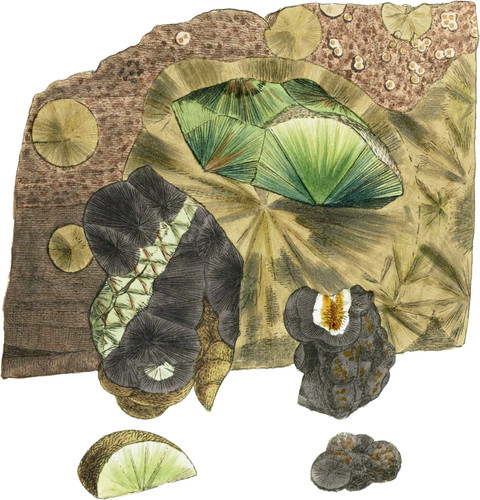 Enlarge
Enlarge
British Mineralogy
Hydrargillite
- Class 2. Earths.
- Order 2. Homogeneous.
- Gen. 1. Argilla.
- Spec. Hydrata.
- Div. 2. Imitative.
In tabs. 134 and 142 I have shown this substance as from Devonshire and Cornwall, nor was it then supposed to exist elsewhere. I hare, however, been favoured with extraordinary specimens by S. Wright, esq. of Cork, found on Spring Hill near Tracton Abbey, about ten miles S. E. of Cork, when digging a foundation for a building. The upper figure is part of a large, apparently separate, botryoidal fragment, of which the radii are three quarters of an inch long, and greener than I had before seen; and where it has been broken and exposed, passes from an ochrey yellow to a black. The left hand mass is somewhat crowded together, resembling dark hæmatites, with a vein of the lighter sort passing in an elegant curve through it. There is also a somewhat stalactitical specimen: See the right hand figure. Below this, there are a few coalesced spherical forms with dark shining radii. Some of the external parts of the above exhibit ends of the crystals, giving it some resemblance to the Sulphate of Barytes figured in tab. 96, and not unaptly resembling Prehnite, tab. 194, but the crystals certainly being of the same form with those in tab. 134.
It is rather singular tint this substance was not found many years ago, when it might have been confounded with Prehntie; but I do not know that it Ins even entered any cabinet under that title, nor has the Irish variety even been called a Zeolite as that from Devonshire was. Dr. Fetton observes that the best specimen he has seen, (procured from the Rev. Mr. Hincks of the Cork Institution,) has diëdral terminations on the external surface; and the Spec. Grav. of the purest part was 2.34.
The figure at the back is from a specimen presented to me by Miss E. Hill, whose ardent desire to prove the fame of the first discovery of this mineral to be due to her brother, the late Mr. John Hill, has prompted her to use every endeavour to show it. He discovered it some lime before the year 1785: see my short Catalogue of Minerals, p, 23. This is a magnificent specimen, and may be compared to the sun. The radii are an inch and a quarter in length; of course the circle is two inches and a half in diameter, and nearly eight inches in circumference, being wonderfully regular, and the largest ever seen: the smaller contiguous circles may be compared to planets; and their satellites, and those near the disk may be considered as analogous to comets, appearing to borrow their light from touching its rays; and they lay so curiously oblique as to show their radii, diverging chiefly in a lateral direction. The opposite side of this specimen has very small hemispheres, of a waxy appearance, semitransparcnt, and greenish, nearly smooth, less than a common pin’s-head, and on a sable ground.
It is not a little extraordinary that this substance seems not to have fallen into the hands of any of the continental writers. It has, however, been found in Spain; but the specimens are destitute of Fluoric Acid, of which the British has a trace.

